
Corinthian order
Encyclopedia
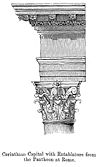
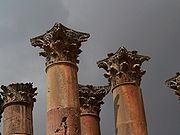
Classical order
A classical order is one of the ancient styles of classical architecture, each distinguished by its proportions and characteristic profiles and details, and most readily recognizable by the type of column employed. Three ancient orders of architecture—the Doric, Ionic, and Corinthian—originated in...
s of ancient Greek
Greece
Greece , officially the Hellenic Republic , and historically Hellas or the Republic of Greece in English, is a country in southeastern Europe....
and Roman
Rome
Rome is the capital of Italy and the country's largest and most populated city and comune, with over 2.7 million residents in . The city is located in the central-western portion of the Italian Peninsula, on the Tiber River within the Lazio region of Italy.Rome's history spans two and a half...
architecture
Architecture
Architecture is both the process and product of planning, designing and construction. Architectural works, in the material form of buildings, are often perceived as cultural and political symbols and as works of art...
. The other two are the Doric
Doric order
The Doric order was one of the three orders or organizational systems of ancient Greek or classical architecture; the other two canonical orders were the Ionic and the Corinthian.-History:...
and Ionic
Ionic order
The Ionic order forms one of the three orders or organizational systems of classical architecture, the other two canonic orders being the Doric and the Corinthian...
. When classical architecture was revived during the Renaissance
Renaissance
The Renaissance was a cultural movement that spanned roughly the 14th to the 17th century, beginning in Italy in the Late Middle Ages and later spreading to the rest of Europe. The term is also used more loosely to refer to the historical era, but since the changes of the Renaissance were not...
, two more orders were added to the canon, the Tuscan order
Tuscan order
Among canon of classical orders of classical architecture, the Tuscan order's place is due to the influence of the Italian Sebastiano Serlio, who meticulously described the five orders including a "Tuscan order", "the solidest and least ornate", in his fourth book of Regole generalii di...
and the Composite order
Composite order
The composite order is a mixed order, combining the volutes of the Ionic order capital with the acanthus leaves of the Corinthian order. The composite order volutes are larger, however, and the composite order also has echinus molding with egg-and-dart ornamentation between the volutes...
. The Corinthian, with its offshoot the Composite, is stated to be the most ornate of the orders, characterized by slender fluted
Fluting (architecture)
Fluting in architecture refers to the shallow grooves running vertically along a surface.It typically refers to the grooves running on a column shaft or a pilaster, but need not necessarily be restricted to those two applications...
column
Column
A column or pillar in architecture and structural engineering is a vertical structural element that transmits, through compression, the weight of the structure above to other structural elements below. For the purpose of wind or earthquake engineering, columns may be designed to resist lateral forces...
s and elaborate capital
Capital (architecture)
In architecture the capital forms the topmost member of a column . It mediates between the column and the load thrusting down upon it, broadening the area of the column's supporting surface...
s decorated with acanthus
Acanthus (ornament)
The acanthus is one of the most common plant forms to make foliage ornament and decoration.-Architecture:In architecture, an ornament is carved into stone or wood to resemble leaves from the Mediterranean species of the Acanthus genus of plants, which have deeply cut leaves with some similarity to...
leaves and scrolls.
The name "Corinthian" is derived from the Greeks of Corinth
Ancient Corinth
Corinth, or Korinth was a city-state on the Isthmus of Corinth, the narrow stretch of land that joins the Peloponnesus to the mainland of Greece, roughly halfway between Athens and Sparta. The modern town of Corinth is located approximately northeast of the ancient ruins...
, although its own in Roman practice, following precedents set by the Temple of Mars Ultor in the Forum of Augustus
Forum of Augustus
The Forum of Augustus is one of the Imperial forums of Rome, Italy, built by Augustus. It includes the Temple of Mars Ultor.-History:The triumvir Octavian vowed to build a temple honoring Mars, the Roman God of War, during the battle of Philippi in 42 BC...
(ca. 2 AD). It is employed in southern Gaul at the Maison Carrée
Maison Carrée
The Maison Carrée is an ancient building in Nîmes, southern France; it is one of the best preserved temples to be found anywhere in the territory of the former Roman Empire.- History :...
, Nîmes (illustration, below) and at the comparable podium temple at Vienne
Vienne
Vienne is the northernmost département of the Poitou-Charentes region of France, named after the river Vienne.- Viennese history :Vienne is one of the original 83 departments, established on March 4, 1790 during the French Revolution. It was created from parts of the former provinces of Poitou,...
. Other prime examples noted by Mark Wilson Jones are the lower order of the Basilica Ulpia and the arch at Ancona
Ancona
Ancona is a city and a seaport in the Marche region, in central Italy, with a population of 101,909 . Ancona is the capital of the province of Ancona and of the region....
(both of the reign of Trajan
Trajan
Trajan , was Roman Emperor from 98 to 117 AD. Born into a non-patrician family in the province of Hispania Baetica, in Spain Trajan rose to prominence during the reign of emperor Domitian. Serving as a legatus legionis in Hispania Tarraconensis, in Spain, in 89 Trajan supported the emperor against...
, 98-117) the "column of Phocas
Column of Phocas
The Column of Phocas , is a Roman monumental column in the Roman Forum of Rome, Italy. Erected before the Rostra and dedicated or rededicated in honour of the Eastern Roman Emperor Phocas on August 1, 608, was the last addition made to the Forum Romanum...
" (re-erected in Late Antiquity
Late Antiquity
Late Antiquity is a periodization used by historians to describe the time of transition from Classical Antiquity to the Middle Ages, in both mainland Europe and the Mediterranean world. Precise boundaries for the period are a matter of debate, but noted historian of the period Peter Brown proposed...
but 2nd century in origin), and the "Temple of Bacchus" at Baalbek
Baalbek
Baalbek is a town in the Beqaa Valley of Lebanon, altitude , situated east of the Litani River. It is famous for its exquisitely detailed yet monumentally scaled temple ruins of the Roman period, when Baalbek, then known as Heliopolis, was one of the largest sanctuaries in the Empire...
(ca. 150 CE).
Roman Corinthian order
Proportion is a defining characteristic of the Corinthian order: the "coherent integration of dimensions and ratios in accordance with the principles of symmetria" are noted by Mark Wilson Jones, who finds that the ratio of total column height to column-shaft height is in a 6:5 ratio, so that, secondarily, the full height of column with capital is often a multiple of 6 Roman feet while the column height itself is a multiple of 5. In its proportions, the Corinthian column is similar to the Ionic columnIonic order
The Ionic order forms one of the three orders or organizational systems of classical architecture, the other two canonic orders being the Doric and the Corinthian...
, though it may be made more slender, but it stands apart by its distinctive carved capital. The abacus
Abacus (architecture)
In architecture, an abacus is a flat slab forming the uppermost member or division of the capital of a column, above the bell. Its chief function is to provide a large supporting surface to receive the weight of the arch or the architrave above...
upon the capital has concave sides to conform to the outscrolling corners of the capital, and it may have a rosette at the center of each side.

Gandharan capitals
Indo-Corinthian capitalIndo-Corinthian capital
Indo-Corinthian capitals are capitals crowning columns or pilasters, which can be found in the northwestern Indian subcontinent, and usually combine Hellenistic and Indian elements...
s are capitals crowning column
Column
A column or pillar in architecture and structural engineering is a vertical structural element that transmits, through compression, the weight of the structure above to other structural elements below. For the purpose of wind or earthquake engineering, columns may be designed to resist lateral forces...
s or pilaster
Pilaster
A pilaster is a slightly-projecting column built into or applied to the face of a wall. Most commonly flattened or rectangular in form, pilasters can also take a half-round form or the shape of any type of column, including tortile....
s, which can be found in the northwestern Indian subcontinent
Indian subcontinent
The Indian subcontinent, also Indian Subcontinent, Indo-Pak Subcontinent or South Asian Subcontinent is a region of the Asian continent on the Indian tectonic plate from the Hindu Kush or Hindu Koh, Himalayas and including the Kuen Lun and Karakoram ranges, forming a land mass which extends...
, and usually combine Hellenistic and India
India
India , officially the Republic of India , is a country in South Asia. It is the seventh-largest country by geographical area, the second-most populous country with over 1.2 billion people, and the most populous democracy in the world...
n elements. These capitals are typically dated to the first centuries of our era, and constitute important elements of Greco-Buddhist art
Greco-Buddhist art
Greco-Buddhist art is the artistic manifestation of Greco-Buddhism, a cultural syncretism between the Classical Greek culture and Buddhism, which developed over a period of close to 1000 years in Central Asia, between the conquests of Alexander the Great in the 4th century BCE, and the Islamic...
of Gandhara
Gandhara
Gandhāra , is the name of an ancient kingdom , located in northern Pakistan and eastern Afghanistan. Gandhara was located mainly in the vale of Peshawar, the Potohar plateau and on the Kabul River...
.
The classical design was often adapted, usually taking a more elongated form, and sometimes being combined with scrolls, generally within the context of Buddhist stupas and temples. Indo-Corinthian capitals also incorporated figures of the Buddha
Gautama Buddha
Siddhārtha Gautama was a spiritual teacher from the Indian subcontinent, on whose teachings Buddhism was founded. In most Buddhist traditions, he is regarded as the Supreme Buddha Siddhārtha Gautama (Sanskrit: सिद्धार्थ गौतम; Pali: Siddhattha Gotama) was a spiritual teacher from the Indian...
or Bodhisattva
Bodhisattva
In Buddhism, a bodhisattva is either an enlightened existence or an enlightenment-being or, given the variant Sanskrit spelling satva rather than sattva, "heroic-minded one for enlightenment ." The Pali term has sometimes been translated as "wisdom-being," although in modern publications, and...
s, usually as central figures surrounded, and often in the shade, of the luxurious foliage of Corinthian designs.


Renaissance Corinthian order
During the first flush of the Italian Renaissance, the Florentine architectural theorist Francesco di GiorgioFrancesco di Giorgio
Francesco di Giorgio Martini was an Italian painter of the Sienese School and a sculptor, as well as being, in Nikolaus Pevsner's terms, "one of the most interesting later Quattrocento architects'" and a visionary architectural theorist; as a military engineer he executed architectural designs and...
expressed the human analogies that writers who followed Vitruvius often associated with the human form, in squared drawings he made of the Corinthian capital overlaid with human heads, to show the proportions common to both.
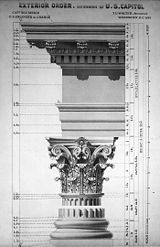
Architrave
An architrave is the lintel or beam that rests on the capitals of the columns. It is an architectural element in Classical architecture.-Classical architecture:...
is divided in two or three sections, which may be equal, or they may bear interesting proportional relationships, one with another. Above the plain, unadorned architrave lies the frieze
Frieze
thumb|267px|Frieze of the [[Tower of the Winds]], AthensIn architecture the frieze is the wide central section part of an entablature and may be plain in the Ionic or Doric order, or decorated with bas-reliefs. Even when neither columns nor pilasters are expressed, on an astylar wall it lies upon...
, which may be richly carved with a continuous design or left plain, as at the U.S. Capitol extension (illustration, left). At the Capitol the proportions of architrave to frieze are exactly 1:1. Above that, the profiles of the cornice moldings are like those of the Ionic order. If the cornice is very deep, it may be supported by brackets or modillions, which are ornamental brackets used in a series under a cornice.
The Corinthian column is almost always fluted. If it is not, it is often worth pausing to unravel the reason why (sometimes simply a tight budget). Even the flutes of a Corinthian column may be enriched. They may be filleted, with rods nestled within the hollow flutes, or stop-fluted, with the rods rising a third of the way, to where the entasis
Entasis
In architecture, entasis is the application of a convex curve to a surface for aesthetic purposes. Its best-known use is in certain orders of Classical columns that curve slightly as their diameter is decreased from the bottom upwards. In the Hellenistic period some columns with entasis are...
begins. The French like to call these chandelles and sometimes they end them literally with carved wisps of flame, or with bellflowers. Alternatively, beading or chains of husks may take the place of the fillets in the fluting, for Corinthian is the most playful and flexible of the orders. Its atmosphere is rich and festive, with more opportunities for variation than the other orders.
Elaborating upon an offhand remark when Vitruvius accounted for the origin of its acanthus capital, it became a commonplace to identify the Corinthian column with the slender figure of a young girl; in this mode the classicizing French painter Nicolas Poussin
Nicolas Poussin
Nicolas Poussin was a French painter in the classical style. His work predominantly features clarity, logic, and order, and favors line over color. His work serves as an alternative to the dominant Baroque style of the 17th century...
wrote to his friend Fréart de Chantelou
Paul Fréart de Chantelou
Paul Fréart de Chantelou was a French collector. He patronised and encouraged major artists of his era, in particular Nicolas Poussin and Gian Lorenzo Bernini .-Chantelou and Poussin:...
in 1642
The beautiful girls whom you will have seen in NîmesNîmesNîmes is the capital of the Gard department in the Languedoc-Roussillon region in southern France. Nîmes has a rich history, dating back to the Roman Empire, and is a popular tourist destination.-History:...
will not, I am sure, have delighted your spirit any less than the beautiful columns of Maison CarréeMaison CarréeThe Maison Carrée is an ancient building in Nîmes, southern France; it is one of the best preserved temples to be found anywhere in the territory of the former Roman Empire.- History :...
for the one is no more than an old copy of the other".
Sir William Chambers expressed the conventional comparison with the Doric order:
The proportions of the orders were by the ancients formed on those of the human body, and consequently, it could not be their intention to make a Corithian column, which, as Vitruvius observes, is to represent the delicacy of a young girl, as thick and much taller than a Doric one, which is designed to represent the bulk and vigour of a muscular full grown man.
History
The oldest known example of a Corinthian column is in the Temple of Apollo Epicurius at BassaeBassae
Bassae or Bassai, Vassai or Vasses , meaning "little vale in the rocks", is an archaeological site in the northeastern part of Messinia Prefecture that was a part of Arcadia in ancient times. Bassae lies near the village of Skliros, northeast of Figaleia, south of Andritsaina and west of Megalopolis...
in Arcadia, ca 450
450 BC
Year 450 BC was a year of the pre-Julian Roman calendar. At the time, it was known as the Second year of the decemviri...
–420 BC
420 BC
Year 420 BC was a year of the pre-Julian Roman calendar. At the time, it was known as the Year of the Tribunate of Cincinnatus, Vulso, Medullinus and Atratinus...
. It is not part of the order of the temple itself, which has a Doric colonnade surrounding the temple and an Ionic order within the cella
Cella
A cella or naos , is the inner chamber of a temple in classical architecture, or a shop facing the street in domestic Roman architecture...
enclosure. A single Corinthian column stands free, centered within the cella. This is a mysterious feature, and archaeologists debate what this shows: some state that it is simply an example of a votive column. A few examples of Corinthian columns in Greece during the next century are all used inside temples. A more famous example, and the first documented use of the Corinthian order on the exterior of a structure, is the circular Choragic Monument of Lysicrates
Choragic Monument of Lysicrates
The Choragic Monument of Lysicrates near the Acropolis of Athens was erected by the choregos Lysicrates, a wealthy patron of musical performances in the Theater of Dionysus to commemorate the award of first prize in 335/334 BCE, to one of the performances he had sponsored...
in Athens, erected ca 334 BC
334 BC
Year 334 BC was a year of the pre-Julian Roman calendar. At the time, it was known as the Year of the Consulship of Caudinus and Calvinus...
.
A Corinthian capital carefully buried in Antiquity in the foundations of the circular tholos
Tholos
Τholos is the name given to several Ancient Greek structures and buildings:**The Tholos at Athens was the building which housed the Prytaneion, or seat of government, in ancient Athens...
at Epidaurus
Epidaurus
Epidaurus was a small city in ancient Greece, at the Saronic Gulf. Two modern towns bear the name Epidavros : Palaia Epidavros and Nea Epidavros. Since 2010 they belong to the new municipality of Epidavros, part of the peripheral unit of Argolis...
was recovered during modern archaeological campaigns. Its enigmatic presence and preservation have been explained by a sculptor's model for stonemasons to follow in erecting the temple dedicated to Asclepius
Asclepius
Asclepius is the God of Medicine and Healing in ancient Greek religion. Asclepius represents the healing aspect of the medical arts; his daughters are Hygieia , Iaso , Aceso , Aglæa/Ægle , and Panacea...
, credited in Antiquity to Polykleitos the Younger
Polykleitos the Younger
Polykleitos the Younger was an ancient Greek sculptor of athletes. His greatest achievements, however, were as an architect. A renowned sculptor, Polykleitos the Younger was architect of the Theatre and Tholos at Epidaurus. Started around 360 BC, the Tholos exhibited elaborate detailing,...
, the son of the Classical Greek sculptor Polykleitos
Polykleitos
Polykleitos ; called the Elder, was a Greek sculptor in bronze of the fifth and the early 4th century BCE...
, the Elder. The temple was erected in the 4th century BCE. These capitals, in one of the most-visited sacred sites of Greece, influenced later Hellenistic and Roman designs for the Corinthian order. The concave sides of the abacus meet at a sharp keel edge, easily damaged, which in later and post-Renaissance practice has generally been replaced by a canted corner. Behind the scrolls the spreading cylindrical form of the central shaft is plainly visible.
Much later, the Roman writer Vitruvius
Vitruvius
Marcus Vitruvius Pollio was a Roman writer, architect and engineer, active in the 1st century BC. He is best known as the author of the multi-volume work De Architectura ....
(c. 75 BCE — c. 15 BCE) related that the Corinthian order had been invented by Callimachus
Callimachus (sculptor)
Callimachus was an architect and sculptor working in the second half of the 5th century BC in the manner established by Polyclitus. He was credited with work in both Athens and Corinth and was probably from one of the two cities...
, a Greek architect and sculptor who was inspired by the sight of a votive basket that had been left on the grave of a young girl. A few of her toys were in it, and a square tile had been placed over the basket, to protect them from the weather. An acanthus
Acanthus (genus)
Acanthus is a genus of about 30 species of flowering plants in the family Acanthaceae, native to tropical and warm temperate regions, with the highest species diversity in the Mediterranean Basin and Asia. Common names include Acanthus and Bear's breeches...
plant had grown through the woven basket, mixing its spiny, deeply cut leaves with the weave of the basket.
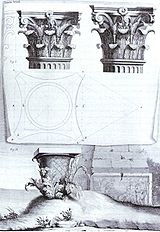
Claude Perrault
Claude Perrault is best known as the architect of the eastern range of the Louvre Palace in Paris , but he also achieved success as a physician and anatomist, and as an author, who wrote treatises on physics and natural history.Perrault was born and died in Paris...
incorporated a vignette epitomizing the Callimachus tale in his illustration of the Corinthian order for his translation of Vitruvius
Vitruvius
Marcus Vitruvius Pollio was a Roman writer, architect and engineer, active in the 1st century BC. He is best known as the author of the multi-volume work De Architectura ....
, published in Paris, 1684 (illustration, left). Perrault demonstrates in his engraving how the proportions of the carved capital could be adjusted according to demands of the design, without offending. The texture and outline of Perrault's leaves is dry and tight compared to their 19th-century naturalism at the U.S. Capitol (below, left). A Corinthian capital may be seen as an enriched development of the Ionic capital, though one may have to look closely at a Corinthian capital (illustration, right) to see the Ionic volute
Volute
A volute is a spiral scroll-like ornament that forms the basis of the Ionic order, found in the capital of the Ionic column. It was later incorporated into Corinthian order and Composite column capitals...
s ("helices"), at the corners, perhaps reduced in size and importance, scrolling out above the two ranks of stylized acanthus leaves
Acanthus (ornament)
The acanthus is one of the most common plant forms to make foliage ornament and decoration.-Architecture:In architecture, an ornament is carved into stone or wood to resemble leaves from the Mediterranean species of the Acanthus genus of plants, which have deeply cut leaves with some similarity to...
and stalks ("cauliculi" or caulicoles), eight in all, and to notice that smaller volutes scroll inwards to meet each other on each side. The leaves may be quite stiff, schematic and dry, or they may be extravagantly drilled and undercut, naturalistic and spiky. In Late Antique and Byzantine practice, the leaves may be blown sideways, as if by the wind of Faith. Unlike the Doric and Ionic column capitals, a Corinthian capital has no neck beneath it, just a ring-like astragal molding or a banding that forms the base of the capital, recalling the base of the legendary basket.

Colosseum
The Colosseum, or the Coliseum, originally the Flavian Amphitheatre , is an elliptical amphitheatre in the centre of the city of Rome, Italy, the largest ever built in the Roman Empire...
— the natural progression is from sturdiest and plainest (Doric) at the bottom, to slenderest and richest (Corinthian) at the top. The Colosseum's topmost tier has an unusual order that came to be known as the Composite order
Composite order
The composite order is a mixed order, combining the volutes of the Ionic order capital with the acanthus leaves of the Corinthian order. The composite order volutes are larger, however, and the composite order also has echinus molding with egg-and-dart ornamentation between the volutes...
during the 16th century. The mid-16th century Italians, especially Sebastiano Serlio
Sebastiano Serlio
Sebastiano Serlio was an Italian Mannerist architect, who was part of the Italian team building the Palace of Fontainebleau...
and Jacopo Barozzi da Vignola, who established a canonic version of the orders, thought they detected a "Composite order
Composite order
The composite order is a mixed order, combining the volutes of the Ionic order capital with the acanthus leaves of the Corinthian order. The composite order volutes are larger, however, and the composite order also has echinus molding with egg-and-dart ornamentation between the volutes...
", combining the volutes of the Ionic with the foliage of the Corinthian, but in Roman practice volutes were almost always present.
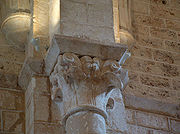
During the 16th century, a sequence of engravings of the orders in architectural treatises helped standardize their details within rigid limits. Sebastiano Serlio
Sebastiano Serlio
Sebastiano Serlio was an Italian Mannerist architect, who was part of the Italian team building the Palace of Fontainebleau...
; the Regola delli cinque ordini
The Five Orders of Architecture
The Five Orders of Architecture is a book on architecture by Giacomo Barozzi da Vignola from 1562, and is considered "one of the most successful architectural textbooks ever written", despite having no text apart from the notes and the introduction...
of Giacomo Barozzi da Vignola
Giacomo Barozzi da Vignola
Giacomo Barozzi da Vignola was one of the great Italian architects of 16th century Mannerism. His two great masterpieces are the Villa Farnese at Caprarola and the Jesuits' Church of the Gesù in Rome...
(1507–1573); the Quattro libri di Architettura of Andrea Palladio
Andrea Palladio
Andrea Palladio was an architect active in the Republic of Venice. Palladio, influenced by Roman and Greek architecture, primarily by Vitruvius, is widely considered the most influential individual in the history of Western architecture...
, and Vincenzo Scamozzi
Vincenzo Scamozzi
thumb|250px|Portrait of Vincenzo Scamozzi by [[Paolo Veronese]]Vincenzo Scamozzi was a Venetian architect and a writer on architecture, active mainly in Vicenza and Republic of Venice area in the second half of the 16th century...
's Idea della Architettura Universale, were followed in the 17th century by French treatises with further refined engraved models, such as Perrault's.
Notable examples
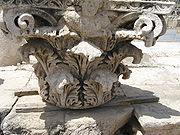

- Greece
- Choragic Monument of LysicratesChoragic Monument of LysicratesThe Choragic Monument of Lysicrates near the Acropolis of Athens was erected by the choregos Lysicrates, a wealthy patron of musical performances in the Theater of Dionysus to commemorate the award of first prize in 335/334 BCE, to one of the performances he had sponsored...
, Athens - Temple of Olympian Zeus (Athens)
- Choragic Monument of Lysicrates
- Rome
- Pantheon, RomePantheon, RomeThe Pantheon ,Rarely Pantheum. This appears in Pliny's Natural History in describing this edifice: Agrippae Pantheum decoravit Diogenes Atheniensis; in columnis templi eius Caryatides probantur inter pauca operum, sicut in fastigio posita signa, sed propter altitudinem loci minus celebrata.from ,...
(illustration) - Temple of Mars Ultor
- Pantheon, Rome
- France
- Maison CarréeMaison CarréeThe Maison Carrée is an ancient building in Nîmes, southern France; it is one of the best preserved temples to be found anywhere in the territory of the former Roman Empire.- History :...
, ParisParisParis is the capital and largest city in France, situated on the river Seine, in northern France, at the heart of the Île-de-France region...
- Maison Carrée
- Portugal
- Templo de Diana, ÉvoraÉvoraÉvora is a municipality in Portugal. It has total area of with a population of 55,619 inhabitants. It is the seat of the Évora District and capital of the Alentejo region. The municipality is composed of 19 civil parishes, and is located in Évora District....
- Templo de Diana, Évora
- Renaissance and Baroque
- Neoclassical and Beaux-Arts
- United States CapitolUnited States CapitolThe United States Capitol is the meeting place of the United States Congress, the legislature of the federal government of the United States. Located in Washington, D.C., it sits atop Capitol Hill at the eastern end of the National Mall...
(illustration) - St. La Salle HallSt. La Salle HallThe St La Salle Hall is an H-shaped four-storey structure built in the neoclassical style. It faces Taft Avenue in the district of Malate in Manila, Philippines...
, Manila - Don Enrique T. Yuchengco HallDon Enrique T. Yuchengco HallThe Don Enrique T. Yuchengco Hall , formerly the Central Administration Building, is a nine-storey neoclassical building located within the campus of De La Salle University in the district of Malate in the city of Manila. It was built on the former location of the Br...
, Manila - Enrique M. Razon Sports CenterEnrique M. Razon Sports CenterThe Enrique M. Razon Sports Center of De La Salle University is a ten-storey neoclassical building that was built in 1998 to replace the old Brother Lucian Athanasius FSC Gym that was demolished in 2000 to give way for the construction of the Yuchengco Hall...
, Manila
- United States Capitol
- Ukraine
- Great Lavra BelltowerGreat Lavra BelltowerThe Great Lavra Belltower or the Great Belfry is the main belltower of the ancient cave monastery of Kiev Pechersk Lavra in Kiev, the capital of Ukraine. It is one of the most notable buildings of the Kiev skyline ....
(fourth tier - 8 columns)
- Great Lavra Belltower
- United Kingdom
- University College LondonUniversity College LondonUniversity College London is a public research university located in London, United Kingdom and the oldest and largest constituent college of the federal University of London...
- University College London
- Germany
- The Reichstag, Berlin
See also
- Classical orderClassical orderA classical order is one of the ancient styles of classical architecture, each distinguished by its proportions and characteristic profiles and details, and most readily recognizable by the type of column employed. Three ancient orders of architecture—the Doric, Ionic, and Corinthian—originated in...
- Doric orderDoric orderThe Doric order was one of the three orders or organizational systems of ancient Greek or classical architecture; the other two canonical orders were the Ionic and the Corinthian.-History:...
- Ionic orderIonic orderThe Ionic order forms one of the three orders or organizational systems of classical architecture, the other two canonic orders being the Doric and the Corinthian...
- Tuscan orderTuscan orderAmong canon of classical orders of classical architecture, the Tuscan order's place is due to the influence of the Italian Sebastiano Serlio, who meticulously described the five orders including a "Tuscan order", "the solidest and least ornate", in his fourth book of Regole generalii di...
- Composite orderComposite orderThe composite order is a mixed order, combining the volutes of the Ionic order capital with the acanthus leaves of the Corinthian order. The composite order volutes are larger, however, and the composite order also has echinus molding with egg-and-dart ornamentation between the volutes...
External links
- "Buffalo, New York, as an Architectural Museum": Amusing concept, well carried through; good illustrations
- Temple of Epicurean Apollo at Bassae

